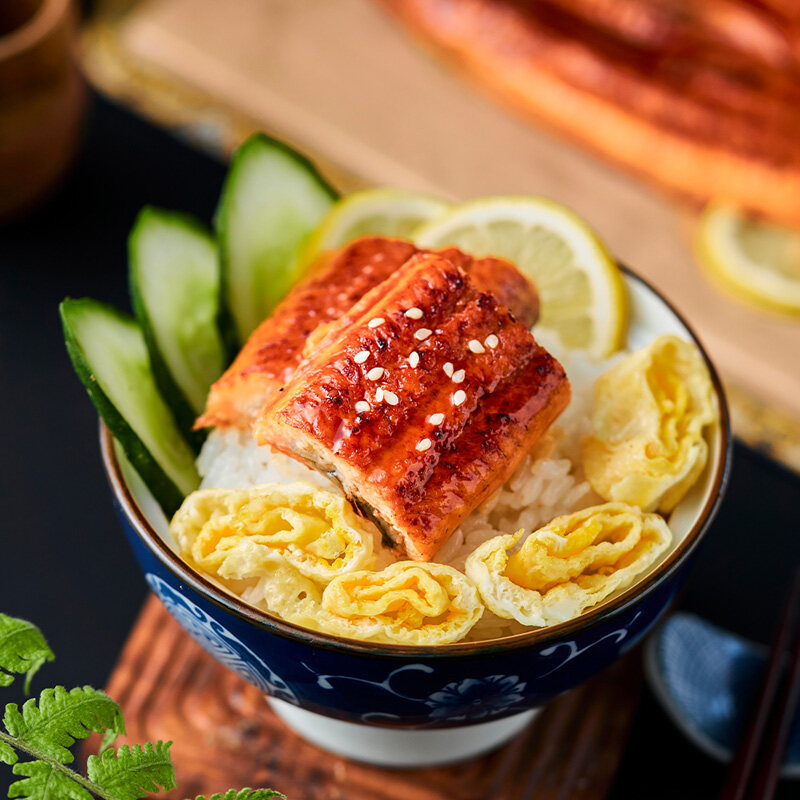Email cannot be empty
Password cannot be empty
Email format error
Email cannot be empty
Email already exists
6-20 characters(letters plus numbers only)
The password is inconsistent
Email format error
Email cannot be empty
Email does not exist
6-20 characters(letters plus numbers only)
The password is inconsistent

Frozen Roasted Eel Cut
Frozen Roasted Eel Cut
(8)These ISO, BRC, HACCP certificated frozen eel foods used for sushi are shaped piece cut, utilize the whole and body of the eels, and have the size of 80g for each.
Main Ingredient for reference:
Eel (Chinese cultured eel), sauce (soy sauce, flavoring, protein hydrolysate, sugar, Rice fermentation seasoning, Kelp extract, eel extract, brewing vinegar, yeast extract)/alcohol, sorbitol, viscosifier (Xanthan gum), (part of wheat, soybean)
Nutrition for reference(100G)
CALORIES(KJ): 358.99, FAT(G): 25.90, CARBOHYDRATE (G): 3.40 PROTEIN(G): 28.60.
Custom demands:
You can customize the sauce content- 10%, 15%, 20%, 25%, and the size and packing can be according to customer needs.
Flavor selection:
Kabayaki Eel Cut, Shirayaki Eel Cut, and Koganeyaki Eel Cut.
Frozen Kabayaki Eel Cut
Seafood is frequently cooked using the grilling technique known as "kabayaki." Initially gutted, boned, and butterflied, the item is then marinated in a mixture of soy sauce, sake, sugar, and other seasonings before being grilled for kabayaki. Grilled eels have been a favorite food in Japan since the Edo era (1603 – 1868). They were a typical supper because they were usually inexpensive. Due to declining eel numbers, they are increasingly expensive and typically consumed as a luxury meal today.
Hot Selling Delicious Seafood Frozen Sumibi Kabayaki Cuts In Sushi Restaurant
Seafood is frequently cooked using the grilling technique known as "kabayaki." Initially gutted, boned, and butterflied, the item is then marinated in a mixture of soy sauce, sake, sugar, and other seasonings before being grilled for kabayaki. Grilled eels have been a favorite food in Japan since the Edo era (1603 – 1868). They were a typical supper because they were usually inexpensive. Due to declining eel numbers, they are increasingly expensive and typically consumed as a luxury meal today.
OEM Customize Wholesale Instant Rice Sushi Japanese Food Frozen Baked unagi Cuts
Seafood is frequently cooked using the grilling technique known as "kabayaki." Initially gutted, boned, and butterflied, the item is then marinated in a mixture of soy sauce, sake, sugar, and other seasonings before being grilled for kabayaki. Grilled eels have been a favorite food in Japan since the Edo era (1603 – 1868). They were a typical supper because they were usually inexpensive. Due to declining eel numbers, they are increasingly expensive and typically consumed as a luxury meal today.
Frozen Koganeyaki Eel Cut
Unagi is thought to have the largest concentration of unsaturated fatty acids of any sea creature and is a powerhouse of nutrients, including protein, omega-3 fatty acids, vitamin E, calcium, vitamin A, and phosphorus. Unagi's omega-3 fatty acids may aid to decrease cholesterol, preserve bone health, control blood pressure, and even ease menstrual pain. This, together with vitamin A, is thought to keep the skin supple and minimise wrinkles.
Frozen Shirayaki Eel Cut
Eels have the abilities to nourish blood, remove moisture, and have anti-tuberculosis properties. Patients with chronic illnesses, weakness, anemia, and tuberculosis can benefit from this nutritional product. Eel is a nutritious dish for young couples, middle-aged people, and elderly people and has a positive effect on enhancing the essence and kidney. An aquatic food that is high in calcium is eel. Regular ingestion helps strengthen the body and raise the blood calcium level.
Factory Price Sale Nutritious Healthy Japanese BBQ Frozen Prepared Eel Unadon Cuts
Seafood is frequently cooked using the grilling technique known as "kabayaki." Initially gutted, boned, and butterflied, the item is then marinated in a mixture of soy sauce, sake, sugar, and other seasonings before being grilled for kabayaki. Grilled eels have been a favorite food in Japan since the Edo era (1603 – 1868). They were a typical supper because they were usually inexpensive. Due to declining eel numbers, they are increasingly expensive and typically consumed as a luxury meal today.
Factory Direct Selling Tender And Juicy Nutritious Healthy Frozen Roasted Eel Cuts
Seafood is frequently cooked using the grilling technique known as "kabayaki." Initially gutted, boned, and butterflied, the item is then marinated in a mixture of soy sauce, sake, sugar, and other seasonings before being grilled for kabayaki. Grilled eels have been a favorite food in Japan since the Edo era (1603 – 1868). They were a typical supper because they were usually inexpensive. Due to declining eel numbers, they are increasingly expensive and typically consumed as a luxury meal today.
Factory Price Wholesale Vacuum Packaged Frozen Grilled Eel Unadon Cuts
Seafood is frequently cooked using the grilling technique known as "kabayaki." Initially gutted, boned, and butterflied, the item is then marinated in a mixture of soy sauce, sake, sugar, and other seasonings before being grilled for kabayaki. Grilled eels have been a favorite food in Japan since the Edo era (1603 – 1868). They were a typical supper because they were usually inexpensive. Due to declining eel numbers, they are increasingly expensive and typically consumed as a luxury meal today.








